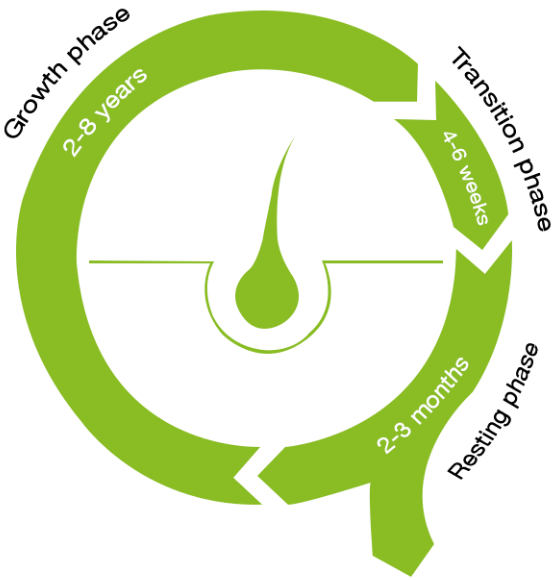About
Number of Capsules
The recommended dose of Priorin®N is 2-3 capsules per day. Take after meals with a glass of water.2
Period of Use
When used as directed, Priorin® N offers an improvement of the hair condition after a few weeks. Since hair growth occurs slowly it is recommended that you take 2-3 Priorin® N capsules daily after meals for a period of 3 to 6 months.2
Important Nutrients
Priorin®N is a restorative product for hair and nails, containing full extract of golden millet, wheat germ oil, cystine and calcium pantothenate. The golden millet, which is rich in vitamins and minerals, is known to solve hair problems. Wheat germ oil contains vitamin E and unsaturated fatty acids. Cystine is a protein constituent (calcium pantothenate is transformed in the body into pantothenic acid) which is an indispensable nutrient that works together with other vitamins for the wellbeing of the scalp.2
Hair root and the three phases of hair growth.14

1. The Anagen Phase: A Time of Hair Growth
During the anagen phase, which is an important stage of the hair growth cycle, there is an increase in metabolic activity in the matrix cells located at the bottom of the hair follicle, just above the papilla. As a result of continual cell division, the bottom of the follicle is pushed deeper into the dermis.
New Hair Formation: New hair begins its growth process by the elongation of new cells, forming a thin filament. These cells then push their way upward into the follicular canal. Once inside the canal, these hair cells undergo differentiation and transform into the cuticle, cortex, and medulla. This transformation process marks the initiation of the keratinization process, which is essential for healthy hair.
In summary, the anagen phase is characterized by increased metabolic activity and the development of new hair cells, which undergo differentiation and become the various components of the hair strand

2. The Catagen Phase: A Transition in Hair Growth
After a period of active hair growth, which can vary depending on the type of hair, the hair follicle enters a brief transitional phase known as catagen. During this stage, cell division ceases, and the base of the hair shaft undergoes full keratinization, resulting in the formation of a dry, white node commonly referred to as a 'club' hair.
Changes in the Follicle: As the catagen phase progresses, the bulb of the hair starts to degenerate, and the follicle itself becomes significantly shorter. This phase marks a transition from active growth to a more dormant state.
In summary, the catagen phase represents a transitional period in the hair growth cycle. During this phase, cell division stops, the base of the hair shaft becomes fully keratinized, and the follicle experiences changes in its structure

3. The Telogen Phase: A Resting Period for Hair
After the transitional stage, the hair follicle enters a resting phase known as the telogen phase. During this period, the hair shaft ceases to grow and remains in the upper portion of the follicular canal. In this state, the hair can be easily removed by pulling.
Duration of the Telogen Phase: The length of time that follicles remain in the telogen phase varies depending on the body area and the individual's age. For scalp hair, the resting phase is relatively short, lasting about 10 weeks.
In summary, the telogen phase represents a period of rest for the hair follicle. During this phase, the hair shaft stops growing and remains in a state where it can be easily shed. The duration of this phase varies, with scalp hair typically having a relatively short resting period of approximately 10 weeks
Reference:
Harkey, M. R. (1992). Anatomy and physiology of hair. Forensic Science International, 63(1-3), 9–18. https://doi.org/10.1016/0379-0738(93)90255-9




